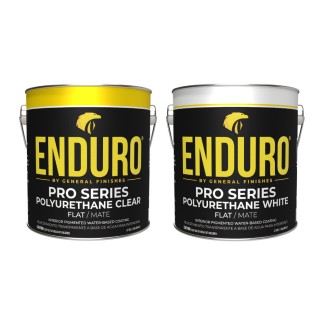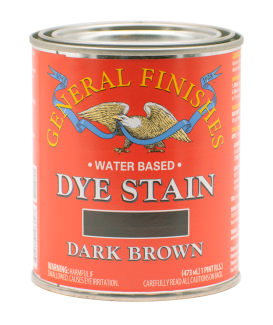


We recommend an oil-based finish such as General Finishes Arm-R-Seal.
Oily woods can be tricky with any topcoat. The high oil content affects the drying process of the finish coats and Padauk has a very high oil content. Sometimes oily woods dry fine and sometimes they take weeks.

ENDURO PRO SERIES SELF CROSS-LINKING CLEAR & WHITE POLY by General Finishes
Get professional performance for a competitive price. This new pair of ENDURO topcoats are tintable, fast-hide coatings for professional and industrial use. The high solids content provides strong build and 2-coat hide when primed with Enduro White Undercoat or General Finishes Stain Blocker.
Although we spray product all the time in our workshop, with several sprayers ranging from airless to HVLP, we do not consider ourselves to be spray gun experts for all brands.
To get the latest information, we recommend you contact Jeff Jewitt of Homestead Finishing Products and/or Paint Sprayers Plus for the best advice.
The most critical part of finishing a piece of furniture happens before you open a can of stain or paint - it starts with the sanding. Sanding is critical to creating a smooth surface. Use the following sanding sequences for new wood:
For wood that is going to be painted, use 120-grit, followed by 150-grit.

Vinyl or paper veneers can be often found on the end returns of lower price-point cabinets. We cannot guarantee that our paints will adhere well to a paper veneer - we have no idea what the actual material is or what adhesives were used to apply the veneer to the surface. The resins and additives in our paints may break down the adhesives used for the veneer.
And Milk Paint does NOT adhere to vinyl.
It is normal to see a bit of stain on the brush when applying the first coat of topcoat. Topcoats often pull a bit of color on the first pass, but good preparation will minimize this.
To prepare open grains woods such as raw Oak for a water-based stain, we recommend sanding with 180-grit followed by no more than 220-grit sandpaper.
Interior wood stains are formulated for interior use and do not contain UV absorbers, mold retardants or HALS (Hindered amine light stabilizers used to protect the polymers from the effects of photo-oxidation.) Waterbased interior stains are much more likely to fail.
You could try this look on an exterior door that will not receive a lot of sun, but be prepared for more maintenance than usual. It is not recommended.
Everyone should note that all exterior finishes need to be maintained at some point - MOTHER NATURE wins the longevity war

Toning is the process of adding colorant, either dye or pigmented stain into a top coat and then applying over an entire piece in order to subtly deepen the color. All of our stains can be used: Stock base colors of RTM, Water-Based Wood Stains or Dye stains. If you are new to toning, we recommend starting with Dyes stains, which can be easier to use as they only contain dyes and no pigments.
It depends on the type of use you plan for your butcher-block top and the look you want.
If it is a statement piece and not intended for high use, almost any finish would work. General Finishes Arm-R-Seal Topcoat is a good choice. If you intend to prep or chop food General Finishes Butcher Block Oil should be applied.